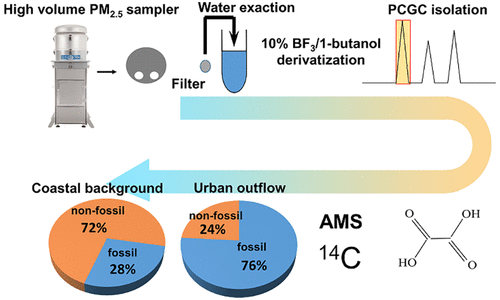当前位置:
X-MOL 学术
›
Environ. Sci. Technol. Lett.
›
论文详情
Our official English website, www.x-mol.net, welcomes your feedback! (Note: you will need to create a separate account there.)
Compound-Specific Radiocarbon Analysis of Low Molecular Weight Dicarboxylic Acids in Ambient Aerosols Using Preparative Gas Chromatography: Method Development
Environmental Science & Technology Letters ( IF 10.9 ) Pub Date : 2021-01-08 , DOI: 10.1021/acs.estlett.0c00887 Buqing Xu 1, 2 , Zhineng Cheng 1 , Örjan Gustafsson 3 , Kimitaka Kawamura 4 , Biao Jin 1 , Sanyuan Zhu 1 , Tiangang Tang 1 , Bolong Zhang 1 , Jun Li 1 , Gan Zhang 1
Environmental Science & Technology Letters ( IF 10.9 ) Pub Date : 2021-01-08 , DOI: 10.1021/acs.estlett.0c00887 Buqing Xu 1, 2 , Zhineng Cheng 1 , Örjan Gustafsson 3 , Kimitaka Kawamura 4 , Biao Jin 1 , Sanyuan Zhu 1 , Tiangang Tang 1 , Bolong Zhang 1 , Jun Li 1 , Gan Zhang 1
Affiliation

|
Low molecular weight dicarboxylic acids constitute a large fraction of atmospheric organic aerosols, which impact atmospheric radiative forcing and hence Earth’s climate. Radiocarbon (14C) is a unique approach to unambiguously distinguishing the relative contributions of biomass-derived and fossil sources. Here, we developed a compound-specific radiocarbon analysis (CSRA) method for individual dicarboxylic acids in atmospheric particulates. Specifically, the method starts with a dibutyl ester derivatization technique, followed by separation and harvesting of single compounds employing a preparative capillary gas chromatography in sufficient amounts for offline 14C measurement with accelerator mass spectrometry. The optimized preparative steps yielded recoveries of >60% and purities of >99% for target molecules. The radiocarbon isotope compositions determined for reference standards taken through the entire method agree well with the original composition of each standard (R2 = 0.9998). The applicability of the approach was demonstrated with ambient aerosol samples representing contrasting air mass regimes. This yielded two radically different yet system-consistent precursor sources. A minimum size of 50 μg of C of ambient dicarboxylic acids is needed for credible 14C measurement. The established method for CSRA of dicarboxylic acids demonstrates a new analytical dimension for studies of the source and evolution of atmospheric secondary organic aerosols.
中文翻译:

使用制备型气相色谱法分析环境气溶胶中低分子量二羧酸的化合物特异性放射性碳:方法开发
低分子量的二羧酸占大气有机气溶胶的很大一部分,这会影响大气的辐射强迫,进而影响地球的气候。放射性碳(14 C)是一种独特的方法,可以明确地区分生物质来源和化石来源的相对贡献。在这里,我们开发了一种化合物特异性放射性碳分析(CSRA)方法,用于分析大气微粒中的单个二羧酸。具体而言,该方法从二丁酯衍生化技术开始,然后使用制备性毛细管气相色谱法分离和收集单个化合物,分离量足以脱机14用加速器质谱法进行C测量。优化的制备步骤对目标分子的回收率> 60%,纯度> 99%。通过整个方法测定的参考标准品的放射性碳同位素组成与每种标准品的原始组成非常吻合(R 2 = 0.9998)。该方法的适用性通过代表对比空气质量状况的环境气溶胶样品得到了证明。这产生了两个根本不同但系统一致的前驱物来源。可信的14需要至少50μg的环境二羧酸CC测量。建立的二羧酸CSRA方法为研究大气次级有机气溶胶的来源和演变提供了一个新的分析维度。
更新日期:2021-02-09
中文翻译:

使用制备型气相色谱法分析环境气溶胶中低分子量二羧酸的化合物特异性放射性碳:方法开发
低分子量的二羧酸占大气有机气溶胶的很大一部分,这会影响大气的辐射强迫,进而影响地球的气候。放射性碳(14 C)是一种独特的方法,可以明确地区分生物质来源和化石来源的相对贡献。在这里,我们开发了一种化合物特异性放射性碳分析(CSRA)方法,用于分析大气微粒中的单个二羧酸。具体而言,该方法从二丁酯衍生化技术开始,然后使用制备性毛细管气相色谱法分离和收集单个化合物,分离量足以脱机14用加速器质谱法进行C测量。优化的制备步骤对目标分子的回收率> 60%,纯度> 99%。通过整个方法测定的参考标准品的放射性碳同位素组成与每种标准品的原始组成非常吻合(R 2 = 0.9998)。该方法的适用性通过代表对比空气质量状况的环境气溶胶样品得到了证明。这产生了两个根本不同但系统一致的前驱物来源。可信的14需要至少50μg的环境二羧酸CC测量。建立的二羧酸CSRA方法为研究大气次级有机气溶胶的来源和演变提供了一个新的分析维度。


























 京公网安备 11010802027423号
京公网安备 11010802027423号